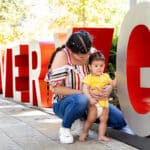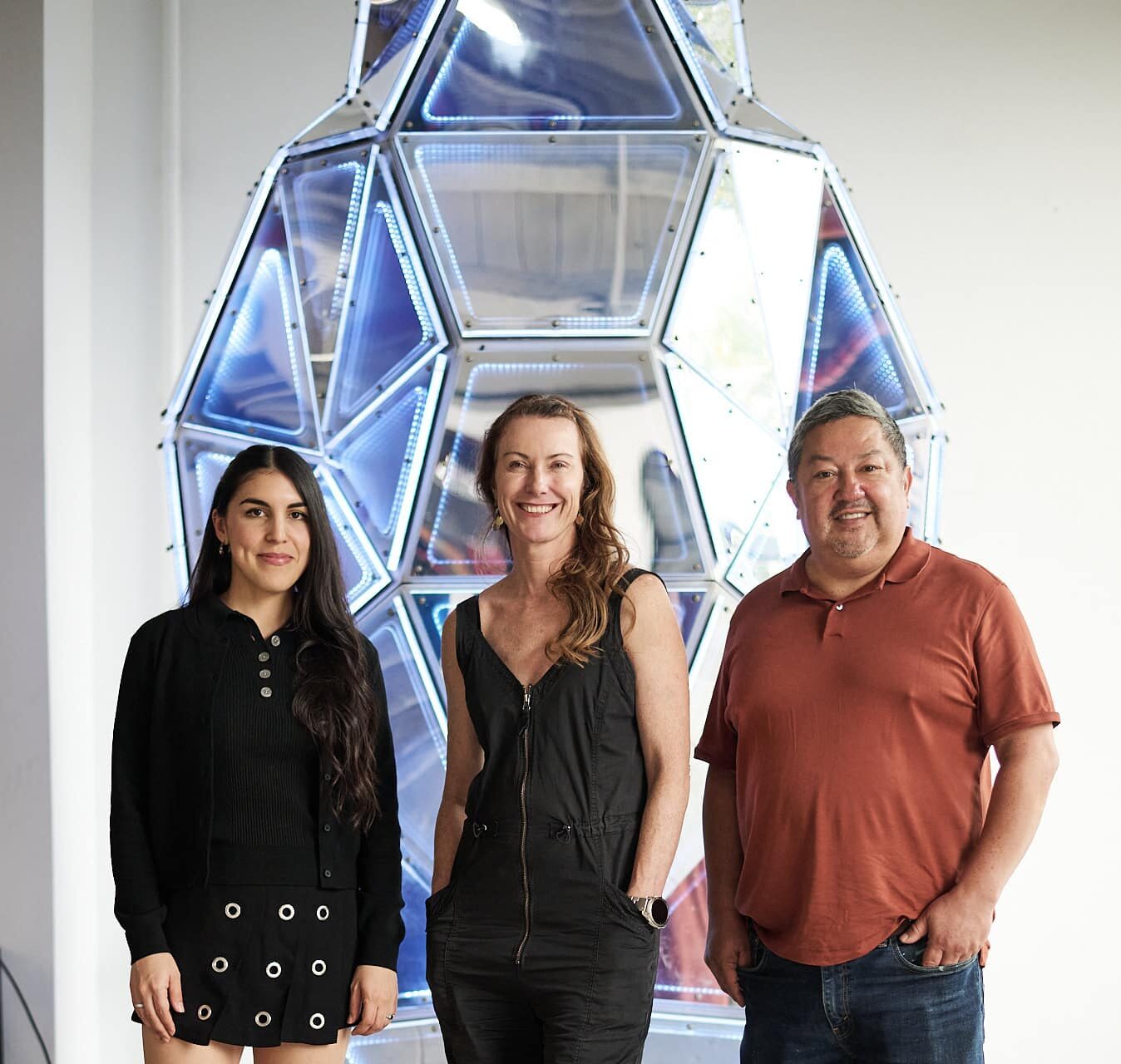Jen Lewin is the inaugural ART LAB mentor and the artist behind this year’s winter art installation at Discovery Green: ATLAS, on view November 15 through February 16.
Consisting of 24 oversized moths hanging from the canopy of the Brown Promenade, visitors will be attracted by ATLAS’s glowing light and harmonious sound emanating from each moth’s body. When parkgoers move beneath the suspended moths, they can interact with and transform these elements.
As an artist Lewin often plays with elements of technology, nature and the interplay between those elements. ATLAS’s name draws inspiration from the Atlas moth which was named after the Titan Atlas from Greek mythology. Lewin’s installation at Discovery Green invites visitors to reflect on how insects as tiny as moths are critical for maintaining healthy environments for the plants that sustain us. The interaction between visitor and Lewin’s oversized moths highlights how people can influence their environment.
On a visit to Houston over the summer, Lewin took some time to answer questions about her process, her artwork and her role as mentor. The following interview has been edited for length and clarity.
Discovery Green: This is your first time at Discovery Green. What are your initial thoughts?
Jen Lewin: It’s beautiful. The Brown Promenade with the trees is dreamy. Seeing it in person is so much more exciting than photos. It’s the perfect vibe for placing art.
DG: Did seeing Discovery Green in person change your ideas?
JL: It didn’t change the concept, but it sparked ideas. Observing the craggy branches and how they move, I began imagining the moths as extensions of the trees, creating a cohesive ecosystem.
DG: What are your thoughts on being the inaugural mentor for Art Lab, Discovery Green’s groundbreaking mentorship program for Houston artists.
JL: I love the concept. It’s a tricky process to become a public artist. I submitted to hundreds and hundreds of calls for art until I was lucky enough to get one. It took so long… years and years to figure it out. Having the opportunity to shadow with a public artist who does this process, would have been amazing for me. To be able to provide that experience –
to facilitate that – sounded great.
DG: You touched on an interesting topic. How does one wake up and think I want to do a large-scale public art? What was that evolution for you?
JL: I always envisioned creating large, experiential pieces. My original course study was in architecture because I wanted things to be large enough that you were in them. But I believed that was just something I was imagining doing. To build the confidence to do something that big, I had to start smaller, but immediately I thought: ‘Oh, if only it could be this big. If only you could dance in it. If only you could move through the whole sculpture.’
It was Burning Man that gave me funding to do a large version of a small something that I had made. Once I got that confidence, I started to think: ‘Hey, you could make some of these things that you’ve been imagining.’ It was a slow learning process.
DG: Discovery Green’s Artistic Director, Susanne Theis noticed many large-scale interactive artists have roots in Burning Man or Montreal because those places have developed communities that value public art. How important are communities in developing this art scene?
JL: At first didn’t really have that community. To be honest, even though Burning Man is an amazing place that gave me a chance. I wasn’t totally, both feet in at Burning Man because I had this inkling – this desire quite frankly – to make something that was more public and accessible. As wonderfully participatory and inclusive Burning Man states to be, it’s an event that most people can’t go to. I wanted to take the work to a public park where there could be kids and grandma and actual real community within the space. I didn’t know, or have anyone else really, that I could talk to about that.
At this point in my life, I would say this is the first time I feel like there’s community. I love being in New York now because there are a bunch of amazing public artists I respect so much. It’s taken me a long time to find that. If there’s a way that a young artist can find that sooner, that seems better.
DG: What was that impulse to create public art for a community people of all types?
JL: I don’t exactly know why. Part of making art is a discovery process. For me, I’m often discovering and learning about myself through the work. The very fact I wanted my art to be interactive has this heart and soul piece where I want to connect with humans, and I want to bring the humans into the work.
In that wanting them to be part of the work, is the desire to understand them all. To create work that is for everyone… that takes understanding. What does it mean if there’s a kid there? Or a teenager? Or grandma? What is it like when it’s in Singapore versus Bahrain?
What is it like to really have this relationship with humans through art, right? I’m just fundamentally interested in connecting with humans. All humans. It’s part of the artwork.
DG: Do you find it difficult to connect with others?
JL: It’s mixed. I can give a speech and be social, but if you put me in a party, I’m hiding in the corner trying to plan the party. I did this giant art piece in Sydney that thousands of people gathered on. It was so fun with fireworks and music. I was under a tree just watching. It’s almost like I made the artwork so I can participate in the whole experience, but in a different way.
DG: So creating art is your way to engage with humanity?
JL: Exactly. It feels natural. Throw me into a crowd and I feel lost. It’s almost like I need a job.
DG: You’ve been so generous with your time. I’ll ask just one more question: Why moths?
JL: My second interactive piece was a robotic butterfly I made in 1999. I was infatuated with this idea of transformation. I was looking at relationships with technology, which also felt extremely transformative in that time. The giant butterfly had these lights that sort of sucked you in. You had to be a part of it. After, I realized it should have been a moth because of the light sucking you in.
So, the very next piece I made after that were these three giant moths. You could touch these light boards and set them to flight. The moth is an interesting animal because in some ways it’s a pest. Some people are very scared of them. Yet they can also be so ethereal and beautiful. As a light artist, the “moths to a flame” idea appeals.
WANT TO GET A LITTLE CLOSER?
PRISM members are a group of supporters who champion Discovery Green’s arts and culture programming. PRISM members invest in the park and Houston’s artists, musicians and other professional creatives. In exchange they get access to behind-the-scenes receptions, private art collection tours, culinary experiences and more. Become a member today at www.discoverygreen.com/prism.
Art Lab is Discovery Green’s groundbreaking mentorship program designed to support underrepresented local artists with the skills and resources necessary to expand their practices into large-scale, interactive sculptural outdoor public works. It is co-created and curated by Weingarten Art Group. Art Lab is funded by an anonymous national foundation.



